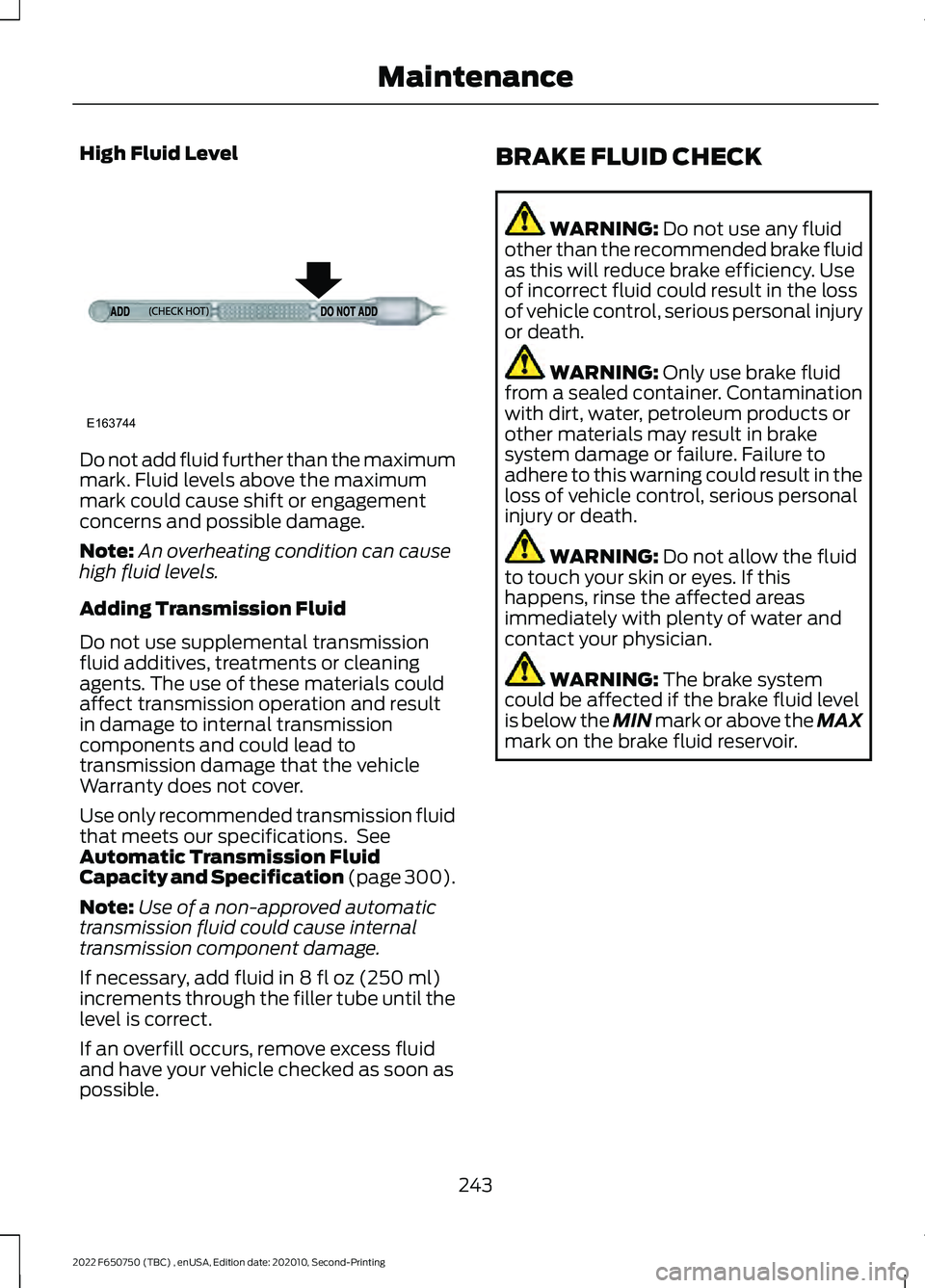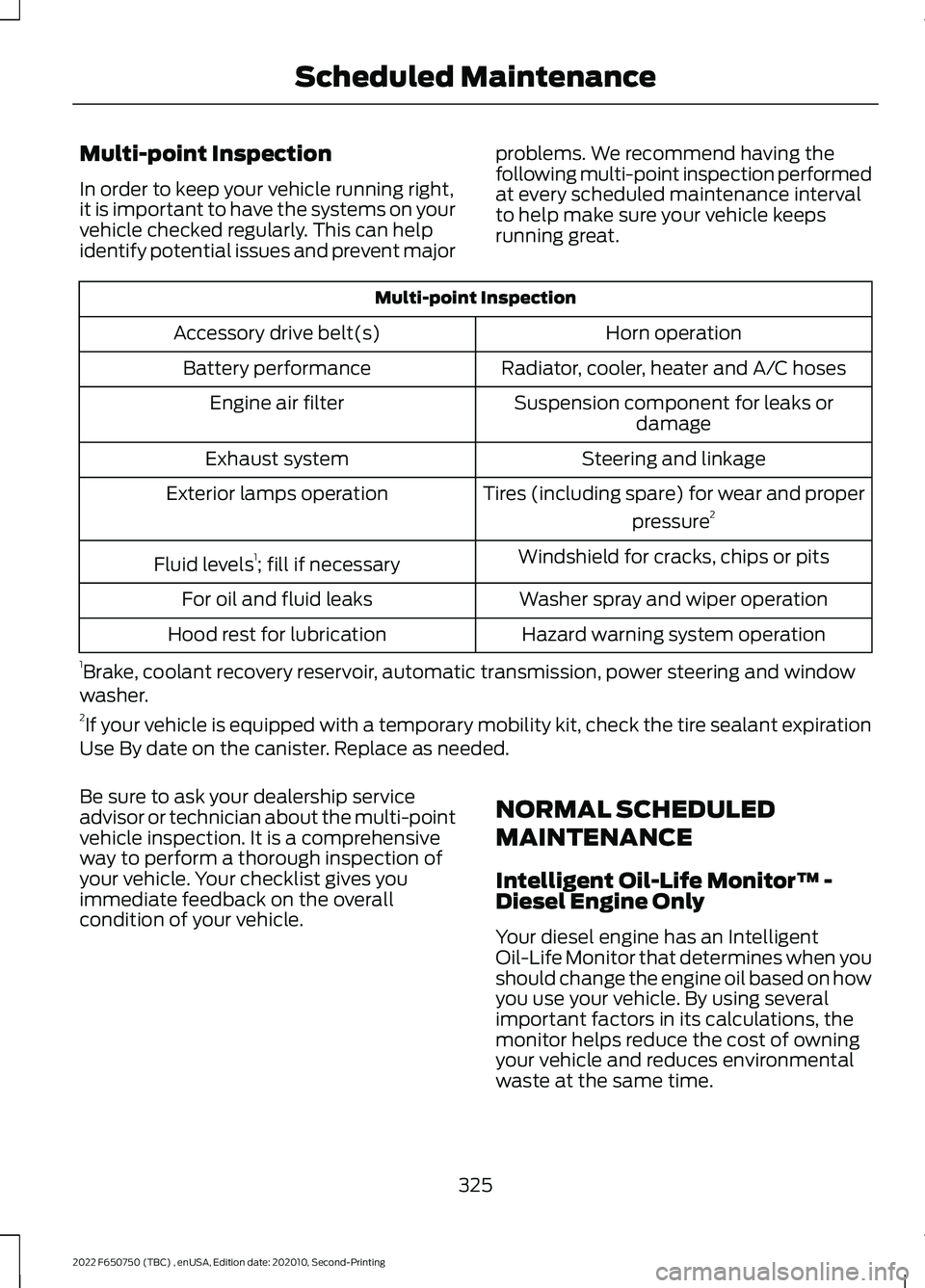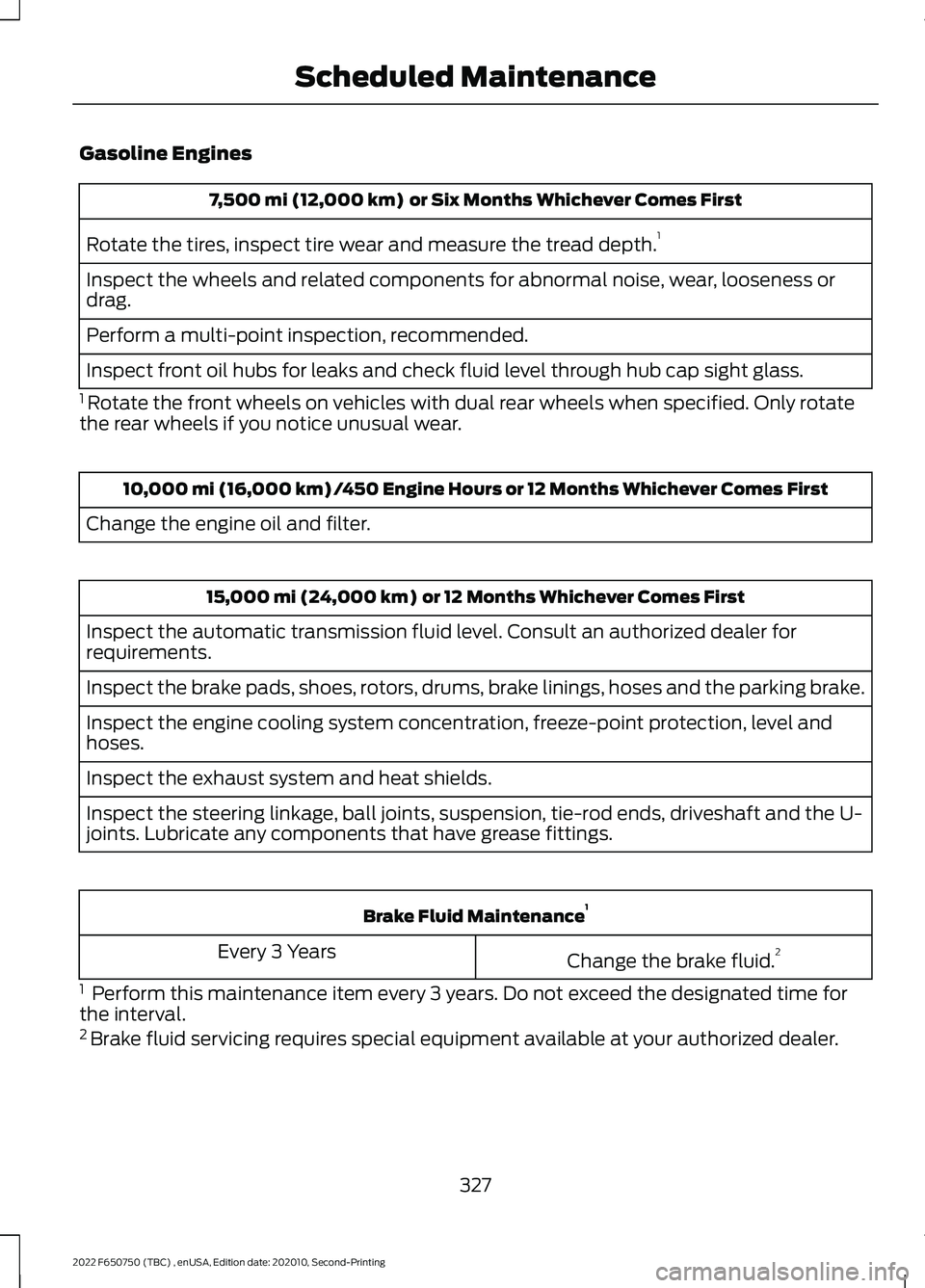2022 FORD F-650/750 check transmission fluid
[x] Cancel search: check transmission fluidPage 244 of 379

4. Check the coolant level. If the coolant
level is at or below the minimum mark,
add prediluted coolant immediately.
5. When the engine temperature cools, you can re-start the engine. Have your
vehicle checked as soon as possible to
minimize engine damage.
Note: Driving your vehicle without repair
increases the chance of engine damage.
Engine Coolant Temperature
Management (If Equipped) WARNING:
To reduce the risk of
crash and injury, be prepared that the
vehicle speed may reduce and the
vehicle may not be able to accelerate
with full power until the coolant
temperature reduces.
If you tow a trailer with your vehicle, the
engine may temporarily reach a higher
temperature during severe operating
conditions, for example ascending a long
or steep grade in high ambient
temperatures.
At this time, you may notice the coolant
temperature gauge moves toward the red
zone and a message may appear in the
information display.
You may notice a reduction in vehicle
speed caused by reduced engine power in
order to manage the engine coolant
temperature. Your vehicle may enter this
mode if certain high-temperature and
high-load conditions take place. The
amount of speed reduction depends on
vehicle loading, grade and ambient
temperature. If this occurs, there is no
need to pull off the road. You can continue
to drive your vehicle. The air conditioning may turn on and off
during severe operating conditions to
protect the engine from overheating. When
the coolant temperature decreases to the
normal operating temperature, the air
conditioning turns on.
If the coolant temperature gauge moves
fully into the red zone, or if the coolant
temperature warning or service engine
soon messages appear in your information
display, do the following:
1. Pull off the road as soon as safely
possible and shift the transmission into
park (P).
2. Leave the engine running until the coolant temperature gauge needle
returns to the normal position. After
several minutes, if the temperature
does not drop, follow the remaining
steps.
3. Switch the engine off and wait for it to
cool. Check the coolant level.
4. If the coolant level is at or below the minimum mark, add prediluted coolant
immediately.
5. If the coolant level is normal, restart the engine and continue.
AUTOMATIC TRANSMISSION
FLUID CHECK
The transmission does not consume fluid.
However, check the fluid level if the
transmission is not working properly, for
example if the transmission slips, shifts
slowly or if there are signs of fluid loss.
Replace the transmission fluid and filter
on your vehicle at the specified service
interval. See
Scheduled Maintenance
(page 321).
Automatic transmission fluid expands
when warmed. To check the fluid level
consistently and accurately, do the
following:
241
2022 F650750 (TBC) , enUSA, Edition date: 202010, Second-Printing Maintenance
Page 245 of 379

1.
Drive the vehicle until it reaches normal
operating temperature. This may take
up to 20 mi (30 km). Make sure that
the transmission fluid temperature
gauge on the instrument cluster is
within normal operating temperature
196– 215°F (91– 102°C)
before
checking.
2. Make sure that your vehicle is on level ground.
3. With the engine running, parking brake
engaged and your foot on the brake
pedal, move the gearshift lever through
all of the gear ranges. Allow sufficient
time for each gear to engage.
4. Make sure the parking brake is on. Make
sure the transmission is in park (P) or
neutral (N) and leave the engine
running.
5. Open the hood. See
Opening and
Closing the Hood (page 219).
6. Remove the dipstick and wipe it with a clean, lint-free cloth. See
Under
Hood Overview (page 221).
7. Replace the dipstick and remove it again to check the fluid level.
8. If the fluid level is correct, replace the dipstick and make sure it is fully seated.
Note: If the fluid level is between the
maximum and minimum marks, the fluid
level is acceptable. Do not add fluid. Transmission Fluid Level
Low Fluid Level If the fluid level is at or below the minimum
mark, add fluid immediately. See
Automatic Transmission Fluid
Capacity and Specification (page 300).
Note:
If there is no indication of fluid on the
dipstick, have your vehicle checked
immediately.
Correct Fluid Level Make sure that the fluid level is between
the maximum and minimum marks.
242
2022 F650750 (TBC) , enUSA, Edition date: 202010, Second-Printing MaintenanceE163740 E163742
Page 246 of 379

High Fluid Level
Do not add fluid further than the maximum
mark. Fluid levels above the maximum
mark could cause shift or engagement
concerns and possible damage.
Note:
An overheating condition can cause
high fluid levels.
Adding Transmission Fluid
Do not use supplemental transmission
fluid additives, treatments or cleaning
agents. The use of these materials could
affect transmission operation and result
in damage to internal transmission
components and could lead to
transmission damage that the vehicle
Warranty does not cover.
Use only recommended transmission fluid
that meets our specifications. See
Automatic Transmission Fluid
Capacity and Specification (page 300).
Note: Use of a non-approved automatic
transmission fluid could cause internal
transmission component damage.
If necessary, add fluid in 8 fl oz (250 ml)
increments through the filler tube until the
level is correct.
If an overfill occurs, remove excess fluid
and have your vehicle checked as soon as
possible. BRAKE FLUID CHECK WARNING:
Do not use any fluid
other than the recommended brake fluid
as this will reduce brake efficiency. Use
of incorrect fluid could result in the loss
of vehicle control, serious personal injury
or death. WARNING:
Only use brake fluid
from a sealed container. Contamination
with dirt, water, petroleum products or
other materials may result in brake
system damage or failure. Failure to
adhere to this warning could result in the
loss of vehicle control, serious personal
injury or death. WARNING:
Do not allow the fluid
to touch your skin or eyes. If this
happens, rinse the affected areas
immediately with plenty of water and
contact your physician. WARNING:
The brake system
could be affected if the brake fluid level
is below the MIN mark or above the MAX
mark on the brake fluid reservoir.
243
2022 F650750 (TBC) , enUSA, Edition date: 202010, Second-Printing MaintenanceE163744
Page 328 of 379

Multi-point Inspection
In order to keep your vehicle running right,
it is important to have the systems on your
vehicle checked regularly. This can help
identify potential issues and prevent major
problems. We recommend having the
following multi-point inspection performed
at every scheduled maintenance interval
to help make sure your vehicle keeps
running great.Multi-point Inspection
Horn operation
Accessory drive belt(s)
Radiator, cooler, heater and A/C hoses
Battery performance
Suspension component for leaks ordamage
Engine air filter
Steering and linkage
Exhaust system
Tires (including spare) for wear and properpressure2
Exterior lamps operation
Windshield for cracks, chips or pits
Fluid levels 1
; fill if necessary
Washer spray and wiper operation
For oil and fluid leaks
Hazard warning system operation
Hood rest for lubrication
1 Brake, coolant recovery reservoir, automatic transmission, power steering and window
washer.
2 If your vehicle is equipped with a temporary mobility kit, check the tire sealant expiration
Use By date on the canister. Replace as needed.
Be sure to ask your dealership service
advisor or technician about the multi-point
vehicle inspection. It is a comprehensive
way to perform a thorough inspection of
your vehicle. Your checklist gives you
immediate feedback on the overall
condition of your vehicle. NORMAL SCHEDULED
MAINTENANCE
Intelligent Oil-Life Monitor™ -
Diesel Engine Only
Your diesel engine has an Intelligent
Oil-Life Monitor that determines when you
should change the engine oil based on how
you use your vehicle. By using several
important factors in its calculations, the
monitor helps reduce the cost of owning
your vehicle and reduces environmental
waste at the same time.
325
2022 F650750 (TBC) , enUSA, Edition date: 202010, Second-Printing Scheduled Maintenance
Page 330 of 379

Gasoline Engines
7,500 mi (12,000 km) or Six Months Whichever Comes First
Rotate the tires, inspect tire wear and measure the tread depth. 1
Inspect the wheels and related components for abnormal noise, wear, looseness or
drag.
Perform a multi-point inspection, recommended.
Inspect front oil hubs for leaks and check fluid level through hub cap sight glass.
1 Rotate the front wheels on vehicles with dual rear wheels when specified. Only rotate
the rear wheels if you notice unusual wear. 10,000 mi (16,000 km) /450 Engine Hours or 12 Months Whichever Comes First
Change the engine oil and filter. 15,000 mi (24,000 km) or 12 Months Whichever Comes First
Inspect the automatic transmission fluid level. Consult an authorized dealer for
requirements.
Inspect the brake pads, shoes, rotors, drums, brake linings, hoses and the parking brake.
Inspect the engine cooling system concentration, freeze-point protection, level and
hoses.
Inspect the exhaust system and heat shields.
Inspect the steering linkage, ball joints, suspension, tie-rod ends, driveshaft and the U-
joints. Lubricate any components that have grease fittings. Brake Fluid Maintenance
1
Change the brake fluid. 2
Every 3 Years
1 Perform this maintenance item every 3 years. Do not exceed the designated time for
the interval.
2 Brake fluid servicing requires special equipment available at your authorized dealer.
327
2022 F650750 (TBC) , enUSA, Edition date: 202010, Second-Printing Scheduled Maintenance
Page 332 of 379

At Every Oil Change Interval as Indicated by the Information Display
1
Perform a multi-point inspection, recommended.
Inspect the air filter restriction gauge. Replace the filter if necessary.
Inspect the automatic transmission fluid level. Consult an authorized dealer for
requirements.
Inspect the brake pads, shoes, rotors, drums, brake linings, hoses and the parking brake.
Inspect the engine and secondary coolant concentration, freeze-point protection, level
and hoses.
Inspect the exhaust system and heat shields.
Inspect the steering linkage, ball joints, suspension, tie-rod ends, driveshaft and the U-
joints. Lubricate any components that have grease fittings.
Inspect front oil hubs for leaks and check fluid level through hub cap sight glass.
1 Do not exceed one year/10,000 mi (16,000 km) or 350 engine hours between service
intervals.
2 Reset the Intelligent Oil-Life Monitor after engine oil and filter changes. See Oil Change
Indicator Reset
(page 226).
3 Rotate the front wheels on vehicles with dual rear wheels when specified. Only rotate
the rear wheels if you notice unusual wear. Brake Fluid Maintenance
1
Change the brake fluid. 2
Every 3 Years
1 Perform this maintenance item every 3 years. Do not exceed the designated time for
the interval.
2 Brake fluid servicing requires special equipment available at your authorized dealer. Other Maintenance Items
1
Replace the engine-mounted and frame-mounted fuel
filters. 2
Every
22,000 mi
(36,000 km)
Inspect the engine and secondary cooling system coolant
concentration, freeze-point protection, additive, corrosion
inhibitor, strength, coolant level, and hoses. Add coolant
additive if necessary.3
Every
30,000 mi
(48,000 km)
329
2022 F650750 (TBC) , enUSA, Edition date: 202010, Second-Printing Scheduled Maintenance
Page 374 of 379

2
2-Speed Rear Axle.......................................135
A
A/C See: Climate Control........................................... 85
About This Manual
...........................................7
ABS See: Brakes........................................................... 136
ABS driving hints See: Hints on Driving With Anti-Lock
Brakes................................................................. 137
Accessories......................................................317
Accessories See: Replacement Parts
Recommendation............................................. 17
ACC See: Using Adaptive Cruise Control.............154
Adjusting the Headlamps........................246
Adjusting the Steering Wheel.....................51
Air Brakes
..........................................................141
Air Conditioning See: Climate Control........................................... 85
Air Conditioning System Capacity and Specification - 6.7L Diesel
....................298
Air Conditioning System Capacity and Specification - 7.3L..................................299
Air Filter See: Changing the Engine Air Filter - 6.7L
Diesel.................................................................. 227
See: Changing the Engine Air Filter - 7.3L..................................................................... 229
Air Induction System Inspection............253
Air Suspension
...............................................175
Appendices....................................................345
At a Glance
.......................................................23
Audible Warnings and Indicators.............69
Audio Input Jack............................................314
Audio System...............................................308 General Information......................................... 308
Audio Unit
......................................................308
Autolamps........................................................55
Automatic High Beam Control.................56
Automatic Transmission
............................128
Automatic Transmission Fluid Capacity and Specification
.....................................300 Automatic Transmission Fluid
Check
..............................................................241
Auxiliary Power Points.................................95
Auxiliary Switches.........................................317
Axle Inspection..............................................257
B
Battery See: Changing the 12V Battery..................... 245
Bonnet Lock See: Opening and Closing the Hood...........219
Booster Seats
..................................................32
Brake Fluid Check........................................243
Brake Fluid Specification...........................301
Brakes...............................................................136 General Information.......................................... 136
Brake System Inspection
..........................254
Breaking-In......................................................185
Bulb Specification Chart
..........................290
C
Canceling the Set Speed
............................161
Capacities and Specifications...............286
Car Wash See: Cleaning the Exterior.............................. 262
Catalytic Converter
.......................................116
Changing a Bulb...........................................249
Changing a Fuse...........................................207
Changing a Road Wheel
...........................283
Changing the 12V Battery.........................245
Changing the Engine Air Filter - 6.7L Diesel.............................................................227
Changing the Engine Air Filter - 7.3L.................................................................229
Changing the Engine-Mounted and Diesel Fuel Conditioner Module Fuel
Filters - 6.7L Diesel...................................250
Changing the Engine Oil and Oil Filter...............................................................225
Changing the Wiper Blades
.....................248
Charging a Device..........................................98
Checking the Wiper Blades.....................248
Child Restraint and Seatbelt Maintenance.................................................44
Child Restraint Positioning
.........................34
371
2022 F650750 (TBC) , enUSA, Edition date: 202010, Second-Printing Index
Page 376 of 379

Engine Oil Capacity and Specification -
6.7L Diesel...................................................290
Engine Oil Capacity and Specification - 7.3L.................................................................293
Engine Oil Check - 6.7L Diesel.................223
Engine Oil Check - 7.3L..............................224
Engine Oil Dipstick - 6.7L Diesel.............223
Engine Oil Dipstick - 7.3L...........................223
Engine Specifications - 6.7L Diesel............................................................286
Engine Specifications - 7.3L.....................287
Entering, Exiting or Climbing on This Vehicle
.............................................................20
Environment......................................................21
Essential Towing Checks
...........................179
Event Data Recording See: Data Recording............................................. 13
Exhaust Brake................................................142
Exhaust System Inspection.....................254
Export Unique Options................................20
Exterior Mirrors...............................................60
F
Fastening the Seatbelts..............................38
Federal Highway Administration Regulation......................................................20
Fifth Wheel Operation...............................180
Flat Tire See: Changing a Road Wheel....................... 283
Ford Credit
..........................................................17
Ford Protect....................................................319
Frame and Tow Hook Inspection..........259
Front Seat Armrest........................................94
Fuel and Refueling.......................................105
Fuel Consumption.........................................112
Fuel Filter - 7.3L
............................................248
Fuel Quality - Diesel....................................106
Fuel Quality - Gasoline..............................109
Fuel Shutoff
...................................................188
Fuel Tank Capacity - Diesel.....................296
Fuel Tank Capacity - Gasoline................297
Fuel Tank Selector Switch..........................114
Fuses.................................................................199
Fuse Specification Chart...........................199 G
Gauges...............................................................63
Gearbox
See: Transmission.............................................. 128
General Driving Points
................................182
General Information on Radio Frequencies...................................................45
General Maintenance Information
.........321
Getting Assistance Outside the U.S. and Canada..........................................................196
Getting the Services You Need................193
H
Handbrake See: Parking Brake.............................................. 137
Hazard Flashers
............................................188
Headlamp Adjusting See: Adjusting the Headlamps..................... 246
Headlamp Exit Delay....................................55
Headlamp Removal See: Removing a Headlamp.......................... 249
Headrest See: Head Restraints.......................................... 88
Head Restraints
..............................................88
Heated Exterior Mirrors................................87
Heating See: Climate Control........................................... 85
Hill Start Assist.............................................140
Hints on Controlling the Interior Climate
...........................................................86
Hints on Driving With Anti-Lock Brakes.............................................................137
Hood Lock See: Opening and Closing the Hood...........219
Horn
.....................................................................52
Hydraulic Power Steering Fluid Capacity and Specification.....................................304
I
Ignition Switch
..............................................100
In California (U.S. Only).............................194
Information Display Control.......................52
Information Displays
.....................................70
General Information............................................ 70
Information Messages..................................74
373
2022 F650750 (TBC) , enUSA, Edition date: 202010, Second-Printing Index